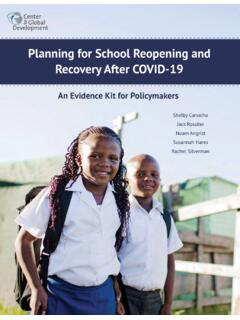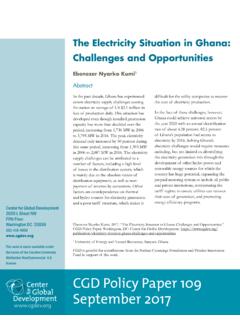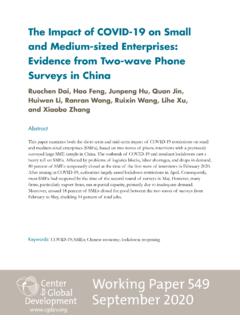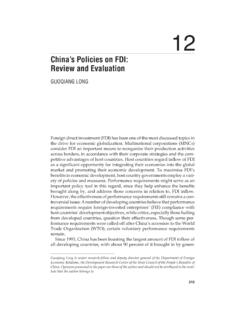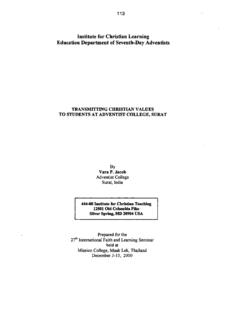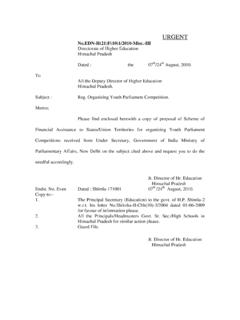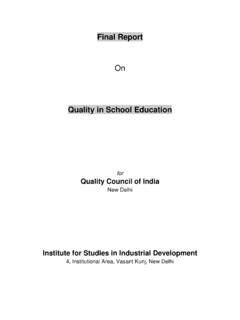Transcription of 5 Girls in India: Poverty, location, and social disparities
1 119 Impressive gains have been made in bridging gender and so-cial gaps in primary education in india , with an estimated 94 percent of all 6- to 13-year-olds now in school. But second-ary enrollment remains under 40 percent. Enrollment and outcomes are particularly weak among scheduled tribes, which make up percent of the population, and scheduled castes, which make up percent (Census of india 2001).1 On the margins of society, these groups have limited access to everything social services, credit, land, and oth-er assets. Membership in these groups is highly correlated with poverty and rural location (more than 70 percent live in rural areas).
2 The depth of social exclusion creates a huge challenge for patriarchal social structure with a strong male prefer-ence predominates in many communities, resulting in gender disparities in all human development indicators (Filmer, King, and Prichett 1998; Siddhanta and Nandy 2003). Discrimination The authors are grateful to Deepa Sankar for her contributions to the litera-ture review and data analysis and to Venita Kaul for constructive Scheduled tribes settled in the subcontinent in prehistoric times and were pushed back to remote areas by successive waves of invasion and settlement. Scheduled castes are those once known as untouchables (Dalits in Hindi).
3 At independence, Dalits and members of indigenous tribes were so oppressed that india s constitution put them on schedules for affirmative action. Quotas are set aside for employing members of scheduled castes and scheduled tribes in the public sector and for admit-ting them to universities in proportion to their shares in the population. Some states, such as Tamil Nadu, have employment and admission quotas for members of other backward in india : Poverty, location, and social disparitiesKin Bing Wu, Pete Goldschmidt, Christy Kim Boscardin, and Mehtabul Azam5120 Girls IN india : POVERTY, LOCATION, AND social disparities against Girls begins before birth abortion, infanticide, and neglect contribute to a skewed gender balance, with only 933 females for every 1,000 males (Census of india 2001).
4 This adds up to 20 million missing females. In recent years the gender balance has become even more skewed in the economically advanced states and Union Territories, such as Punjab and New Delhi, where readily available ultrasound technology can identify the gender of the fetus (Census of india 2001). The balance is also more skewed among children in the highest-spending households (measured by monthly per capita expenditure). The top 5 percent of rural households have 804 female children for every 1,000 male children (891 in urban households), compared with 946 female children in the bottom 5 percent (903 in urban households) (Siddhanta, Nandy, and Agnihotri 2005).
5 In 2001 75 percent of males and just 54 percent of females were literate (Census of india 2001). Rural women are twice as likely to be illiterate. Gender bias intersects with social exclusion: reaching Girls from scheduled castes and tribes is particularly chapter reviews Girls enrollment and achievement, as well as the key fac-tors contributing to gender and social gaps in india . It asks several questions:What are the barriers to Girls education? What accounts for the progress in narrowing gender and social gaps in enrollment and achievement in pri-mary education (grades 1 8)?How large are the gender and social disparities in access to secondary edu- cation (grades 9 10)?
6 Are some Girls more vulnerable than others during the transition to secondary education?What determines achievement in secondary education? The chapter draws on four datasets: the government s National Sample Surveys, the National Health and Family Surveys, the Sixth and seventh All india Education Surveys, and two surveys of government and private secondary schools in Rajasthan and Orissa conducted by the authors in 2005. It also draws on the literature on Indian education and the Ministry of Human Resource Development s Selected Education Statistics and Analysis of Budgeted Expenditure on chapter begins by reviewing Girls enrollment and achievement in primary school.
7 It then describes gender and social gaps in access to secondary education and explores the reasons for the disparities . Next, it examines gender and social gaps in secondary certificate examination pass rates across states. It assesses the determinants of achievement in Rajasthan and Orissa and their policy implications. The last section suggests broader conclusions and policy and achievement in primary schoolIndia has made extraordinary progress in enrollment. In 2002 an estimated 25 mil-lion children (13 percent of the age cohort) were out of school (World Bank 2004). By Girls IN india : POVERTY, LOCATION, AND social disparities 121 2005 this number had been roughly halved, with only about million children aged 6 13 (less than 7 percent of the cohort) out of school ( social and Rural Research Institute 2005).
8 2 The age-specific enrollment in primary education is nearly 94 per-cent. Another household study conducted by civic action groups finds similar enroll-ment rates (Annual Status of Education Report 2006). About 8 percent of Girls and rural children are not enrolled in school (table ). These figures are higher than those for boys (6 percent) and for children from urban areas (4 percent). About two-thirds of these children have never attended school and a third of them have dropped out. About half of all out-of-school children are physically or mentally challenged. Those out of school include 38 percent of children with disabilities, 10 percent of Mus-lim children, 10 percent of children from scheduled tribes, and 8 percent of children from scheduled castes.
9 Much progress has been made in extending access to primary school to Girls , children from scheduled castes and tribes, and poor and rural children. Between 1987 and 2005, more children from all social groups entered the system earlier and stayed longer, and the increase in the enrollment of Girls and previously excluded groups was higher than that of boys (figures and ). Children from the poorest quintile nar-rowed the gap with those from the top (figure ), and rural children narrowed the gap with those from cities (figure ). But significant gaps still separate the general Hindu population from sched-uled castes and tribes, other backward castes, and Muslims.
10 These gaps are far greater among Girls , with Girls from scheduled tribes the worst off (figure 5. 5).2 This sample-based household study was commissioned by the Ministry of Human Resource Develop-ment to validate the education status of school-age children. The survey was based on the sampling frame of National Sample Survey and so is nationally representative. Its findings are consistent with the state household surveys and with those of the Annual Status of Education Report Percentage of out-of-school children in india , by age group, 2005 GroupAge group6 1011 136 : social and Rural Research Institute (2005).122 Girls IN india : POVERTY, LOCATION, AND social DISPARITIESWhat keeps Girls out of primary school?
